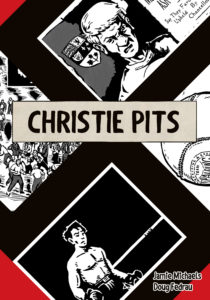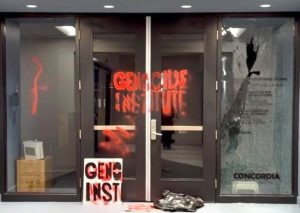Winnipeg native Jamie Michaels was in his mid-20s when he first heard about the Christie Pits riot of 1933. He said he was surprised that as a Canadian Jew he had grown up without knowing that anti-Semitism had ignited the biggest race riot in Canadian history.

Michaels, 31, thought all Canadians should know this story and so he wrote and published Christie Pits (Dirty Water Comics, 2019), a graphic novel illustrated by Doug Fedrau. “The fact that I’d never heard about the riot prompted me to write the book,” he said.
For his research, Michaels examined archives, old newspapers and scholarly books and he interviewed some of the family members of people who had witnessed or participated in the riot.
READ: CHRISTIE PITS, THE COMIC
On Aug. 16, 1933, about 10,000 people got involved in a melee that erupted after a baseball game in Christie Pits, a park in downtown Toronto. It was a playoff game between a Jewish-Italian team and an Anglo team.
A brawl started when some Jewish teens tried to confiscate a large Swastika banner displayed at the game by some spectators. The fighting spread from the park to the streets.
Christie Pits was launched recently at Beth Tzedec Congregation in Toronto in conjunction with the synagogue’s exhibition on Jews and the comic book industry, which runs until mid-May.
Michaels offered a short dramatic reading from the book, which included a “reenactment” of the famous heavyweight fight between Max Schmeling and Max Baer in June 1933.
Christie Pits provides historical context for the riot by integrating fictional characters with historical events like the Schmeling/Baer bout and the Toronto workers’ walkout and great demonstration against Hitlerism in July 1933.
Michaels said he wanted to create a book that would be “exciting and consumable and appeal to young people,” and so he chose the graphic novel format. “It’s the fastest-growing sector of the publishing industry.”
The storyline in Christie Pits focuses on a cast of fictional characters. The bookish Yiddel and his athletic brother, Areyeh, are two teenagers who have immigrated to Canada from Germany.
They are friends with Tev, a tough and argumentative university student, and Sammy, a pugnacious lightweight amateur boxer.
The gentile characters include the Marxist Sofia, Tev’s Italian girlfriend, her disapproving brothers, as well as the bullies from the Pit Gang and Swastika clubs.
Much of the story takes place in the College and Spadina area, the centre of Jewish life in Toronto in the 1930s. Christie Pits was some distance from the old Jewish neighbourhood and Michaels says that the Pit Gang viewed the Jewish players and spectators at Christie Pits as “trespassers.”
He suggests that this territoriality may have been an incentive for the anti-Semitic bating that led to the riot. “We were here first,” the gang members say. “The Jews can have Spadina. They’ve already ruined it.”
A chapter set in Europe provides Yiddel and Areyeh’s backstory. Following a pogrom in Ukraine, their parents, as well as their aunt, Rochelle, and uncle, Fieval, find refuge in Berlin. Later, Rochelle and Fieval immigrate to Canada with Yiddel and Areyeh. Their parents plan to follow, but by the time they’re ready to leave Germany, Canada has closed its borders to Jews.
A real Canadian historical figure is then introduced. Rochelle asks her MP, Sam Factor, for help with her sister’s immigration file.
In 1933, anti-Semitism in Toronto was blatant, but Michaels shows that other immigrant groups like the Italians were also the target of xenophobia. He said Christie Pits is relevant today because it’s a lesson on how to treat newcomers. “It shows how rhetoric can escalate and it explores how these tensions can lead to violence.”






